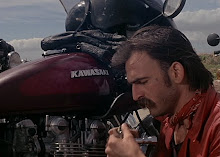It's 1955.
You are sitting on the hillside at
Reims-Gueux, the public-roads-turned-racing-circuit between Thillois and Gueux in France. Looking down from your spot, you can see turn six, Viragede la Garenne, a treacherous kink in the long back-straight.
Grabbing another slice of cheese, another slice of bread and another sip of wine, you listen to the symphony of machines screaming past you as you dine.
There is the low, rhythmic rumble of the single-cylinder
Nortons. Following are the exotic wails of the four-cylinder
Gileras and
MV Agustas. Next is the low rumble of the single-cylinder
Matchless' and the flat-twin
BMWs as they battle for position.
Then, you hear a sound so ethereal approaching, it snaps you away from your French mid-day meal in an instant.
Barreling toward you, setting up for the kink in the road, is the oddest-looking motorcycle you have ever seen.
It has a strange green tub of a fairing. It completely covers the entire front of the machine, with only two cooling slots to break up the tub-like styling. A massive clear-plastic windscreen towers up over the rider.
Clinging perilously to the top of the polished aluminum fuel tank is the black-leather-clad rider. He's contorted in the classic racer's position: arms outstretched, clutching the clip-on handle bars, his knees tucked in close to his body and his weight placed over the rear wheel.
As polarizing as the sight of this machine is, it's the sounds that gets you.
It's an other-worldly howl not heard on any racing circuit before. It's the howl of a high number of cylinders spinning at a high number of revs.
As quickly as this seemingly alien craft is upon you, it passes you by. You take one last look as it speeds away, belching fire from the exhausts as the rider upshifts.
All around you, people discuss the sight in a mixture of languages. They all share the same sense of wonder and amazement at the green-and-sliver blur that came howling past.
What you and the rest of the people at Reims-Gueux experienced was the
Moto Guzzi V8.
The Moto Guzzi V8 was conceived by Moto Guzzi's cheif engineer, Dr. Giulio Carcano, to not only compete in the ultra-competitive world of Grand Prix racing but to showcase Moto Guzzi's engineering prowess.
Typical racing machines of the day were not too far removed from their street-ridden brethren.
The British were fond of pushrod, air-cooled single-cylinder engines. Italian companies like Gilera and MV Agusta used dual overhead cam, four-cylinder engines that were very high-tech for the time, but still relied on ambient air for cooling. BMW used their flat-twin that was designed in 1923, hardly ground-breaking in 1955.
The Guzzi V8 was on another planet compared to its competition.
The V8 was 499cc (500cc being the maximum for Grand Prix) and featured liquid-cooling, four camshafts (two per bank), eight 20mm Dell'Orto carburetors (one per cylinder) and eight sets of points (again, one set per cylinder).
In race trim, the V8 produced 78 horsepower at a staggering 12,000rpm. Funneling this power to the road was a choice of a four-, five- or six-speed transmission.
One of the most amazing things about the V8 was that all told, it only weighed 99lbs. Total weight for the motorcycle was only 330lbs.
Stuffing an eight-cylinder engine in a motorcycle frame was a feat unto itself. This necessitated a compact design for the V8. All of the components were so tightly packed together, the V8 almost resembled a scale model.
The odd styling was also a necessity. The tub fairing, called a dust-bin at the time, helped the V8 cut through the wind. The six-speed gearbox, low weight and incredible power gave this machine a top speed of 171mph. It wasn't until the seventies that a grand prix machine would be capable of that kind of speed again.
Sadly, while the V8 was an engineering marvel, it was a failure in reality.
With eight carburetors and eight sets of points, it was a high-maintenance nightmare; nevermind the fact that it liked to break crankshafts, seize and overheat. Sometimes all three happened at the same time.
Also, period motorcycle frame design could not cope with 78 horsepower or 171mph. Stopping relied upon out-dated drum brakes that were prone to locking up when applied quickly, overheating in hot temperatures, and being almost murderous in wet weather.
The V8 competed for three seasons, in 1955, 1956 and 1957. The best finish for the Moto Guzzi team was sixth place in 1955, with Englishman Bill Lomas at the V8's helm.
The V8 was just too radical for the time. Chassis and brake technology just couldn't keep up with the V8's speed, making it a very dangerous motorcycle to ride. Fergus Anderson, Moto Guzzi's racing director, crashed the machine on its maiden voyage. Factory rider Ken Kavanagh refused to ride the V8 at Spa-Francorchamps in 1956.
Moto Guzzi pulled out of Grand Prix racing after the 1957 season and the V8's short but breathtaking career was over. Two examples remain in Moto Guzzi's museum in Mandello del Lario, Italy.
It's common speculation that with further development, the V8 could've re-written the Grand Prix history books. As it stands now, The Moto Guzzi V8 is an interesting footnote in the continuous evolution of the motorcycle.
Definitely not pretty but brutally effective. The V8's dust-bin fairing allowed the machine to cut through the wind toward its top-speed of 171mph.
A triumph of compact proportions, the 499cc V8 was crammed into a motorcyle frame and let loose on the unsuspecting racetracks of Europe.










